“Gladiator II” Costume Designers Janty Yates and David Crossman on Lunatic Emperors & Blood-Splattered Warriors
She won an Oscar for outfitting the first Gladiator, and 20 years later, costume designer Janty Yates once again teamed with Ridley Scott to cloak ancient Rome’s ruling class in bespoke finery. Gladiator II stars Paul Mescal as a slave who fights his way to freedom, with Denzel Washington, Pedro Pascal, Connie Nielsen, Joseph Quinn, and Fred Hechinger in featured roles. Yates and military expert David Crossman, who costumed the downtrodden gladiators, crafted over 2,000 costumes for the sequel.
Speaking jointly from a West Hollywood hotel, Yates and Crossman discuss the film’s Johnny Rotten factor, deconstruct Washington’s deluxe togas, and explain the gladiator fringe known as pteruges.
The insane twin emperors Gata and Caracalla, Joseph Quinn and Fred Hechinger, make a striking pair in their beautiful robes. Janty, how did you arrive at that look?
Janty Yates: Basically, Ridley’s brief for the twins was Johnny Rotten. We had a wonderful start because Ridley wanted them to be red-haired and ashen-faced, and one of them has a gold tooth. Ridley wanted the twins to look quite mad, so it was great fun to dress them. We used beautiful early 20th-century saris and encrusted them in jewelry.
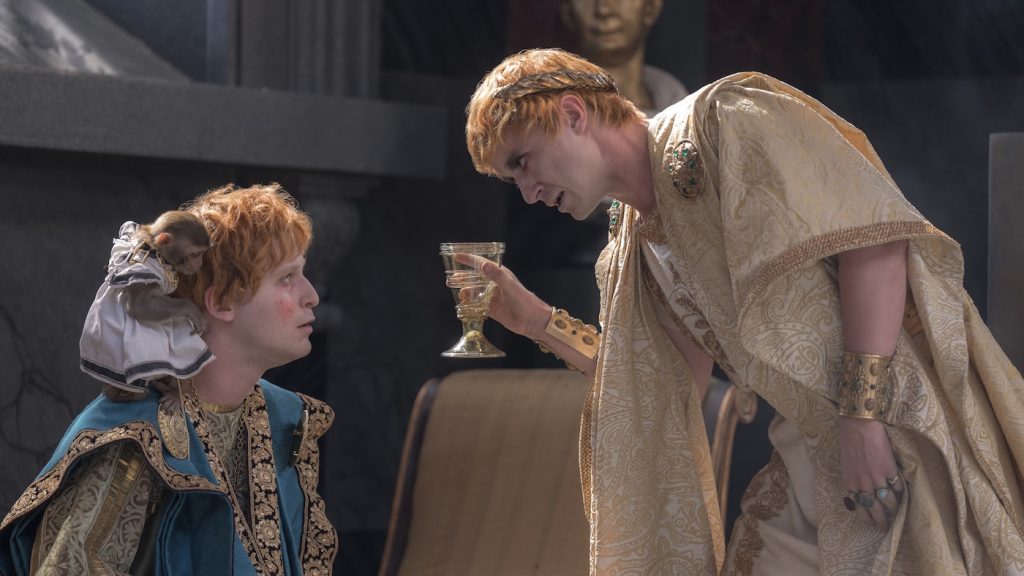
Wait, saris like Indian saris?
Janty: They were Indian saris, masculine but with a feminine feel. We also made two or three black saris, which went with some wonderful embroidered panels that I bought at Les Puces, the flea market in Paris. We also used Italian and French fabrics, very rich damask, as the base and just put layer on layer. The boys [actors Joseph Quinn and Fred Hechinger] had never worn anything like it before, and they were completely gob-smacked. “You want me to wear what?”
The ruling class characters are all beautifully draped. What’s the inspiration?
Janty: Well, it’s based on the tunic and the toga, which is usually draped over one shoulder or maybe both shoulders and then wrapped around the arms to hang down in very long lengths of fabric. Underneath is the tunic. The females could be off the shoulder.
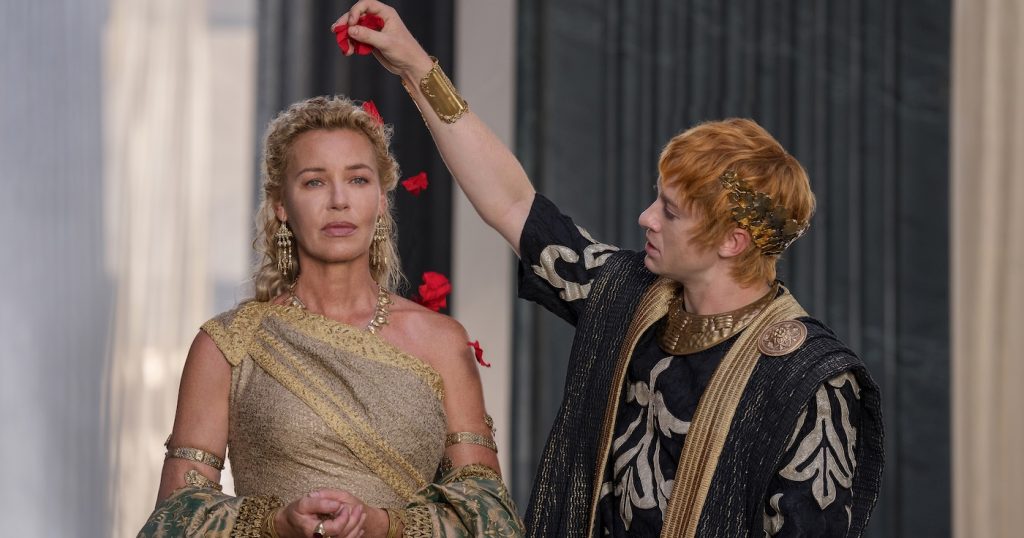
Like for Connie Nielsen’s Lucilla character. And then there’s the gold.
Janty: We had gold on gold on gold, and then we put some more gold on [laughing]. And David created the glorious gold [breastplate] cuirasses. They were made by our wonderful leather worker Jean Paulo, who used wonderful horse characters printed in etcetera in 3D. I was actually only going to put one of them in the cuirasses [breastplate] but they looked so brilliant together we had to go with two.
SPOILER ALERT
After vanquishing North Africa, Pedro Pascal’s General Acacius returns victorious to Rome. David, how did you approach Acacius “conquering hero” look?
David Yates: For his’ triumphal arrival back in Rome, Acacius wears a parade costume made of a lovely soft white, Pierre’s golden pieces and this lovely, embroidered piece.
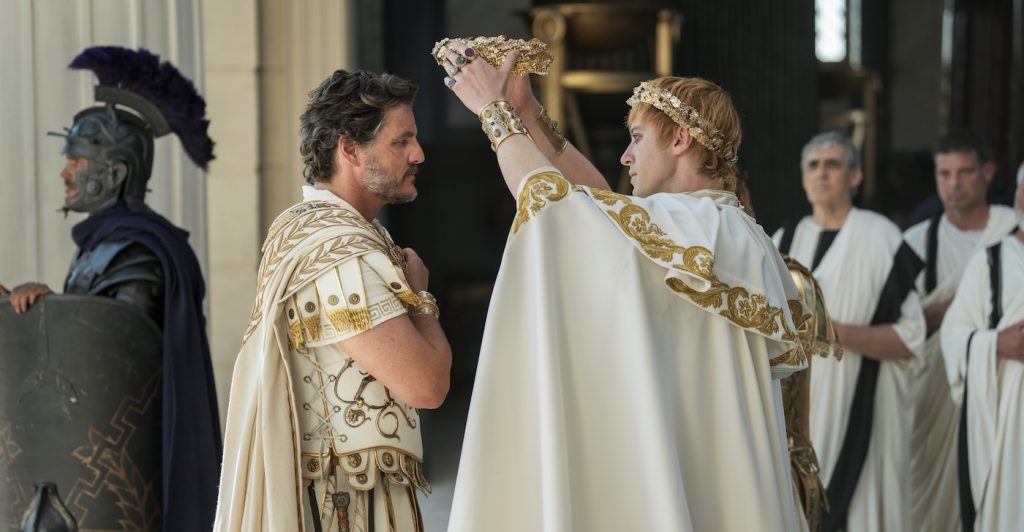
Even when he enters the coliseum to fight, Acacius’s breastplate looks more elegant than the other gladiators.
David: It has a Medusa. We’d found a nice head from a Roman emblem and just kept adding serpents so they spread over the chest in a more dramatic way—a kind of Medea power logo, I suppose.
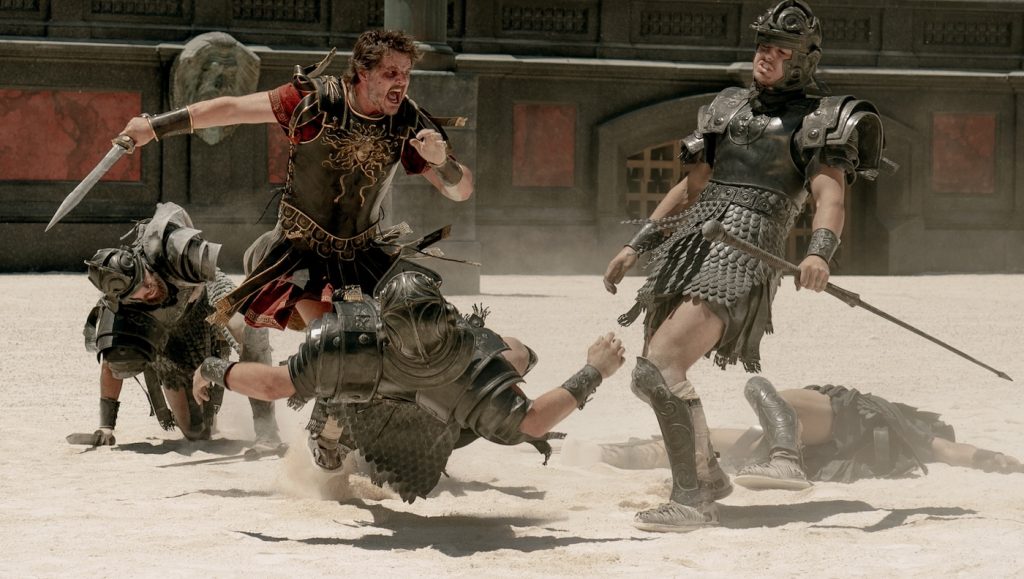
SPOILER ALERT
Early on, Denzel Washington’s Macrinus appears in this throne-like chair wearing a sumptuous cream-white gown. How did you fit the clothes to his personality?
Jonty: The costume you’re talking about, he’s in the suburbs, and there’s that baboon fight. [On set] I thought, “He’s looking quite low-key today, and that’s good,” because Macrinus does have an arc. But when I saw the film, Denzel is so strong in his closeup, really magnificent, and I thought, “Oh, you’re not doing it right, you shouldn’t be this wonderful!” He was far too commanding.
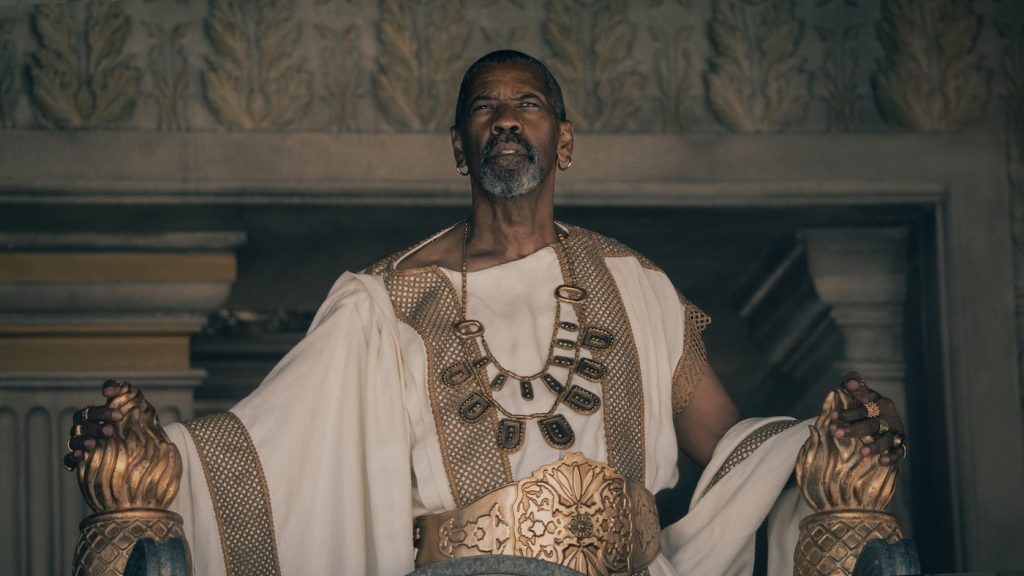
Where did you go from there?
Jonty: We brought Macrinus to Rome and added various layers on top of his toga. We gave him a heavy necklace and wristlets, bangles, and a ring on each finger. There was talk about turbans, but Denzel and Ridley didn’t want one. But Denzel wore earrings throughout, which I was delighted with. It gives Macrinus that slight oriental quirk.
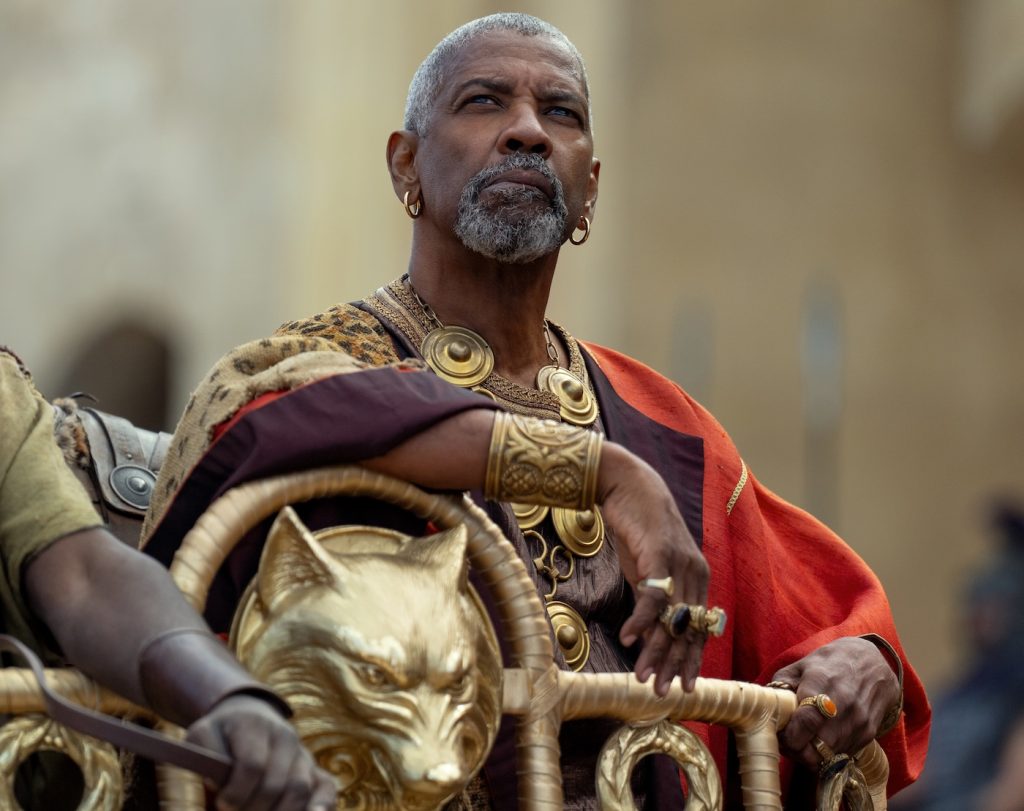
As in Napoleon, you use color to create excitement on the screen. Here, Macrinus and the other rulers dress in rich reds, purples, and blues. How did this palette inform what was going on with the characters?
Janty: In those days [of ancient Rome], having anything dyed was very expensive, so we wanted to imply that Macrinus made a lot of money through his wheeling and dealing. We pushed the envelope because they would never have had the fabrics we used — Italian silk, for example — as well as French and Italian gold bullion trim.
To show they were rich?
Jonty: To show they were so rich, especially the emperors. But also, as Ridley said, this is not a documentary. We did our research but went a bit off the beaten path, shall we say.
David, you outfitted somewhere around 150 “gladiators,” including Lucius. Did you individualize each outfit?
David: We started with Paul Mescal’s Lucius as our jumping-off point, so all the gladiators tie in with what he looks like. Then, we tried to individualize each costume with little personalizations.
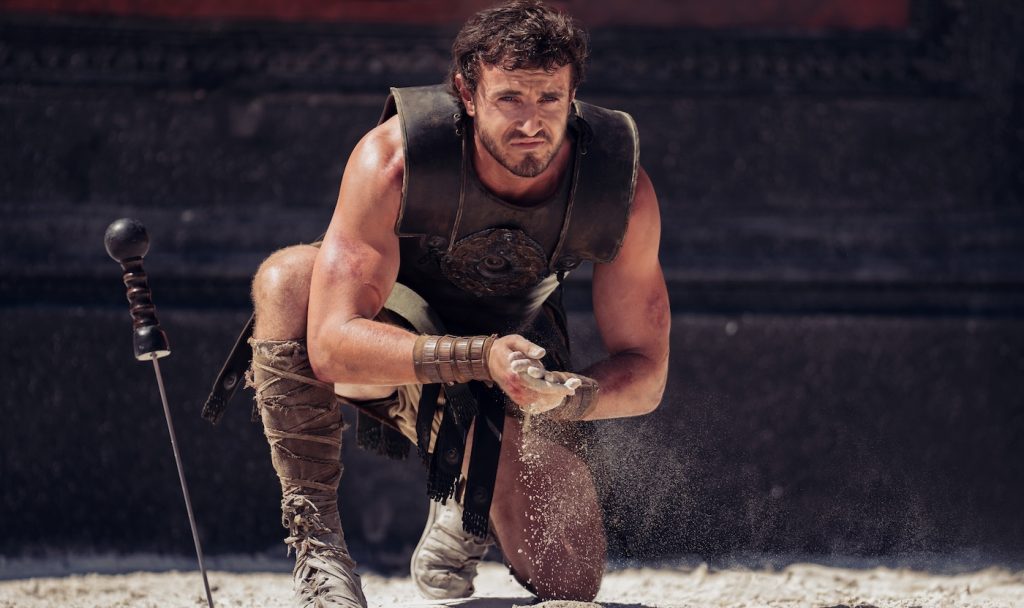
All the gladiators wear skirts fringed with strips. What’s that about?
They’re called pteruges — strips of leather that form a kind of skirt offering an element of protection. It’s that classic silhouette, the breastplate, and then the pteruges that move as you move.
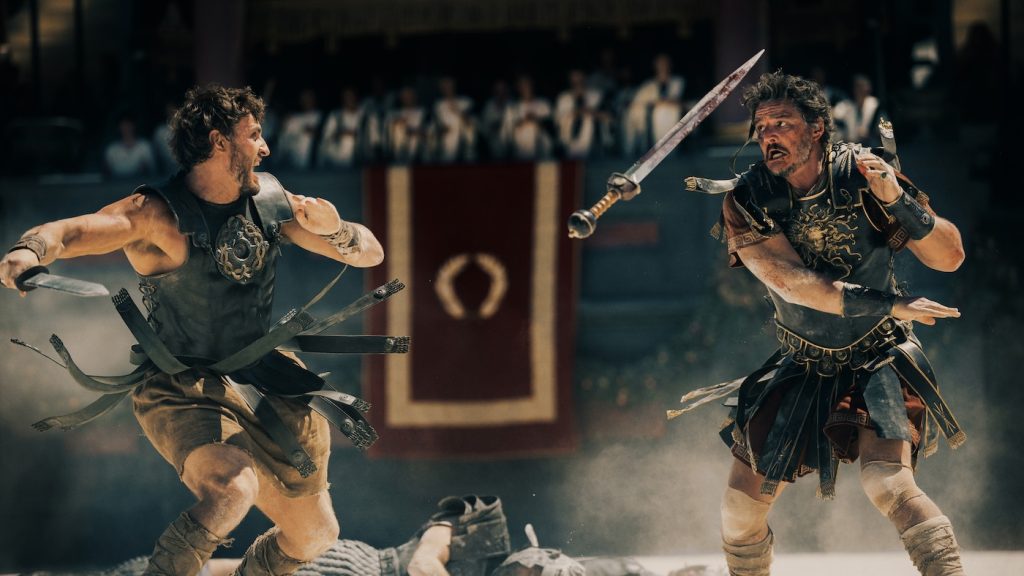
Your ardrobe team created more than 2,000 costumes. How does production at that scale impact the local communities where you filmed in terms of vendors, artisans, and crew members?
Janty: Huge impact. In Morocco, hotels were agog because so many people worked there on the film. We had local breaker-downers [who treat clothes so they look aged], dyers, costume assistants, hair and make-up. In Malta, our production designer Arthur [Max] used hundreds of plasterers, painters, and again, we used local costomers and breaker-downers
Janty, you began working with Ridley Scott on this movie in October 2022. David, you started in January 2023. The movie only wrapped in March. What do you take away from the Gladiator II experience?
David: I enjoyed it a lot more than I thought I would. I love the Roman period, and I loved doing the armor. Ridley was great…
Janty: And the cast was absolutely glorious. By the time we left Malta, we’d all fallen in love with the extras, we’d made a lot of friends, and we got to work with wonderful artisans. It was great fun.
For more on Gladiator, check out these stories:
“Gladiator II” Cinematographer John Mathieson on Capturing Robotic Rhinos & Colossal Carnage
“Gladiator II” Production Designer Arthur Max on Rebuilding a Decadent, Debased Ancient Rome
Maximus Effort: “Gladiator II” Production Designer Arthur Max’s on Creating Colossal Constructions
Featured image: Paul Mescal plays Lucius and Christopher Edward Hallaways plays Glyceo in Gladiator II from Paramount Pictures.



